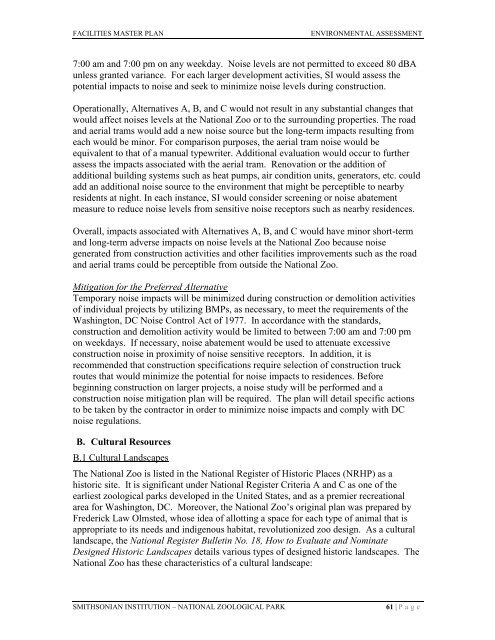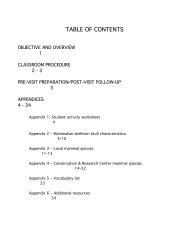facilities renewal master plan - National Zoo - Smithsonian Institution
facilities renewal master plan - National Zoo - Smithsonian Institution
facilities renewal master plan - National Zoo - Smithsonian Institution
You also want an ePaper? Increase the reach of your titles
YUMPU automatically turns print PDFs into web optimized ePapers that Google loves.
FACILITIES MASTER PLAN ENVIRONMENTAL ASSESSMENT<br />
7:00 am and 7:00 pm on any weekday. Noise levels are not permitted to exceed 80 dBA<br />
unless granted variance. For each larger development activities, SI would assess the<br />
potential impacts to noise and seek to minimize noise levels during construction.<br />
Operationally, Alternatives A, B, and C would not result in any substantial changes that<br />
would affect noises levels at the <strong>National</strong> <strong>Zoo</strong> or to the surrounding properties. The road<br />
and aerial trams would add a new noise source but the long-term impacts resulting from<br />
each would be minor. For comparison purposes, the aerial tram noise would be<br />
equivalent to that of a manual typewriter. Additional evaluation would occur to further<br />
assess the impacts associated with the aerial tram. Renovation or the addition of<br />
additional building systems such as heat pumps, air condition units, generators, etc. could<br />
add an additional noise source to the environment that might be perceptible to nearby<br />
residents at night. In each instance, SI would consider screening or noise abatement<br />
measure to reduce noise levels from sensitive noise receptors such as nearby residences.<br />
Overall, impacts associated with Alternatives A, B, and C would have minor short-term<br />
and long-term adverse impacts on noise levels at the <strong>National</strong> <strong>Zoo</strong> because noise<br />
generated from construction activities and other <strong>facilities</strong> improvements such as the road<br />
and aerial trams could be perceptible from outside the <strong>National</strong> <strong>Zoo</strong>.<br />
Mitigation for the Preferred Alternative<br />
Temporary noise impacts will be minimized during construction or demolition activities<br />
of individual projects by utilizing BMPs, as necessary, to meet the requirements of the<br />
Washington, DC Noise Control Act of 1977. In accordance with the standards,<br />
construction and demolition activity would be limited to between 7:00 am and 7:00 pm<br />
on weekdays. If necessary, noise abatement would be used to attenuate excessive<br />
construction noise in proximity of noise sensitive receptors. In addition, it is<br />
recommended that construction specifications require selection of construction truck<br />
routes that would minimize the potential for noise impacts to residences. Before<br />
beginning construction on larger projects, a noise study will be performed and a<br />
construction noise mitigation <strong>plan</strong> will be required. The <strong>plan</strong> will detail specific actions<br />
to be taken by the contractor in order to minimize noise impacts and comply with DC<br />
noise regulations.<br />
B. Cultural Resources<br />
B.1 Cultural Landscapes<br />
The <strong>National</strong> <strong>Zoo</strong> is listed in the <strong>National</strong> Register of Historic Places (NRHP) as a<br />
historic site. It is significant under <strong>National</strong> Register Criteria A and C as one of the<br />
earliest zoological parks developed in the United States, and as a premier recreational<br />
area for Washington, DC. Moreover, the <strong>National</strong> <strong>Zoo</strong>’s original <strong>plan</strong> was prepared by<br />
Frederick Law Olmsted, whose idea of allotting a space for each type of animal that is<br />
appropriate to its needs and indigenous habitat, revolutionized zoo design. As a cultural<br />
landscape, the <strong>National</strong> Register Bulletin No. 18, How to Evaluate and Nominate<br />
Designed Historic Landscapes details various types of designed historic landscapes. The<br />
<strong>National</strong> <strong>Zoo</strong> has these characteristics of a cultural landscape:<br />
SMITHSONIAN INSTITUTION – NATIONAL ZOOLOGICAL PARK 61 | P a g e

















